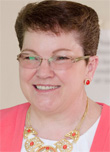Operation Warp Speed: How Did Clinical Sites Pivot To Meet Vaccine Study Demands?
A conversation with Cynthia M. Dukes, PA, MT, chief business officer, Benchmark Research

With a pandemic such as COVID-19, time is of the essence as the virus claims lives, overwhelms healthcare systems, upends daily life, and destabilizes the global economy. These vaccine clinical studies demanded the highest priority by the clinical trial sites conducting them. Thus, this global pandemic highlighted the importance of innovation and adaptability in day-to-day operations of clinical trial sites. Cynthia Dukes, PA, MT, chief business officer of Benchmark Research, addresses the multifaceted challenges of speed and volume of work that required introduction of many changes relative to basic operations, subject recruitment and retention, staffing, and quality data delivery. Benchmark Research is a nine-site network with a core focus in vaccines, diagnostics, and infectious disease clinical trials.
How did Operation Warp Speed (OWS) and the pandemic change what sites require to manage large studies that change rapidly?
 DUKES: The pandemic and OWS accelerated the speed of clinical trial starts and subject enrollment. Sites went from three or four new study starts per quarter to three or four new starts per month. Subject enrollment doubled, tripled, or quadrupled the usual rate per month and had to enroll more subjects in a shorter period of time. As a result, sites had to quickly change how they operationally approach clinical trials and how they were staffed.
DUKES: The pandemic and OWS accelerated the speed of clinical trial starts and subject enrollment. Sites went from three or four new study starts per quarter to three or four new starts per month. Subject enrollment doubled, tripled, or quadrupled the usual rate per month and had to enroll more subjects in a shorter period of time. As a result, sites had to quickly change how they operationally approach clinical trials and how they were staffed.
Was there any additional oversight added due to OWS?
DUKES: With the accelerated work effort, it was critical to put in place additional checks and balances to ensure the safety of the subjects and the quality of the data. This included the use of technology, facility modifications and expansions, and alignment of staff roles to meet the goals for enrollment.
What measures were taken to meet these demands?
DUKES: It became clear that our facilities were somewhat rate limiting, so, depending on the facility, we expanded with trailers, additional leased space, and flexible work “shifts” to disperse workload over a larger time frame and extend hours of staff coverage and subject enrollment. Remote working was implemented for non-subject facing tasks (EDC, file maintenance, safety calls, etc.) and additional “stations” were created in the clinics to process volunteers more quickly, all while respecting the requirements for social distancing, masking, and sanitizing.
In addition to facilities, new technology in the form of electronic regulatory document files and electronic subject source records were implemented to facilitate greater efficiency in operations and transparency for our leadership and staff as well as CRAs and other sponsor staff.
How did you increase staff to accommodate the need?
DUKES: Our staff numbers virtually tripled. This included expanding the number of CRCs as well as adding new roles such as remote CRCs, dedicated EDC staff, safety call specialists, vaccine administration specialists, and QC specialists. These additions allowed our subject-facing staff to have greater focus on enrollment and subject-related tasks while having other staff attend to the administrative or non-subject-facing activities. By moving select non-subject-focused staff to remote work, expanding our hours, and adding a variety of shifts with varying hours, we were able to accommodate all the new hires and expand our hours to accommodate increased enrollment, while at the same time developing more efficient processes via electronic regulatory files and electronic subject source records while maintaining overall high-quality execution.
How were subjects identified and enrolled so quickly?
DUKES: Due to the nature of the pandemic and general press coverage, many people were interested in enrolling in the COVID-19 studies. Social media advertising and local TV interviews drove a huge number of callers to our call center. In order to meet this huge demand, we expanded our call center of six by more than 40 through a service in the Philippines. This remote/offshore call center was staffed by local nurses who spoke very good English, and this allowed us to pre-screen and schedule interested subjects 24/7.
How did you accommodate the 6-foot social distancing guidelines to protect employees and subjects from COVID?
DUKES: Our facilities are all different sizes and floor plans. Local directors and staff adapted the facilities by removing and moving furniture, moving non-subject-facing staff off-site, scheduling subjects appropriately, and moving subjects through the clinic more quickly by having stations set up for specific tasks, therefore establishing somewhat of a one-direction assembly line flow of subjects through the clinics.
Our staff and everyone entering our building were required to complete a COVID-19 exposure/symptom questionnaire, have a temperature taken, and wear a mask covering their nose and mouth. If anyone coming into the clinic did not have a mask, one was provided to them.
For ill subject visits, how did you minimize exposure to healthy staff and volunteers in the clinic?
DUKES: Depending on the site location, different methods were established. Where allowed, trailers were brought in for illness visits. Other sites did visits at the subject’s car or brought subjects into a dedicated exam room near a separate entrance where the ill subject was not required to walk through any common spaces.
Our staff wore full PPE for these visits, with gowns, bonnets, gloves, booties, masks, and face shields. After each visit these were disposed of in a dedicated biohazard hamper and ultimately disposed of per OSHA guidelines.
What did you do to ensure quality execution?
DUKES: A QC specialist role was deployed. Working either on-site or remotely, the QC specialist reviewed data in real time to ensure eligibility, protocol compliance, and accurate data recording. This improved the overall quality of site activities enormously and minimized the number of deviations by 38%. QC specialists also tracked numerous metrics and provided the management team with monthly reports so that additional network-wide changes in processes, etc., could be adapted if required.
What learnings will you take with you as sites execute future clinical trials?
DUKES: I think the overarching lesson learned here is the need for flexibility and out of the box thinking by our leadership team. The pandemic challenged the traditional approach to clinical trial execution and required that we move forward quickly with changes to meet the workload and the needs of people engaged (staff, volunteers, pharma representatives, etc.). In a regulated environment, we are traditionally overly cautious and slow to implement change; however, in this case, keeping the impact of the pandemic on morbidity and mortality of the disease, our mindset was what can we do? and how can we do it quickly?.
Cynthia Dukes thanks Chris Yates, Texas A&M MPH intern, for assistance with this Q&A.
